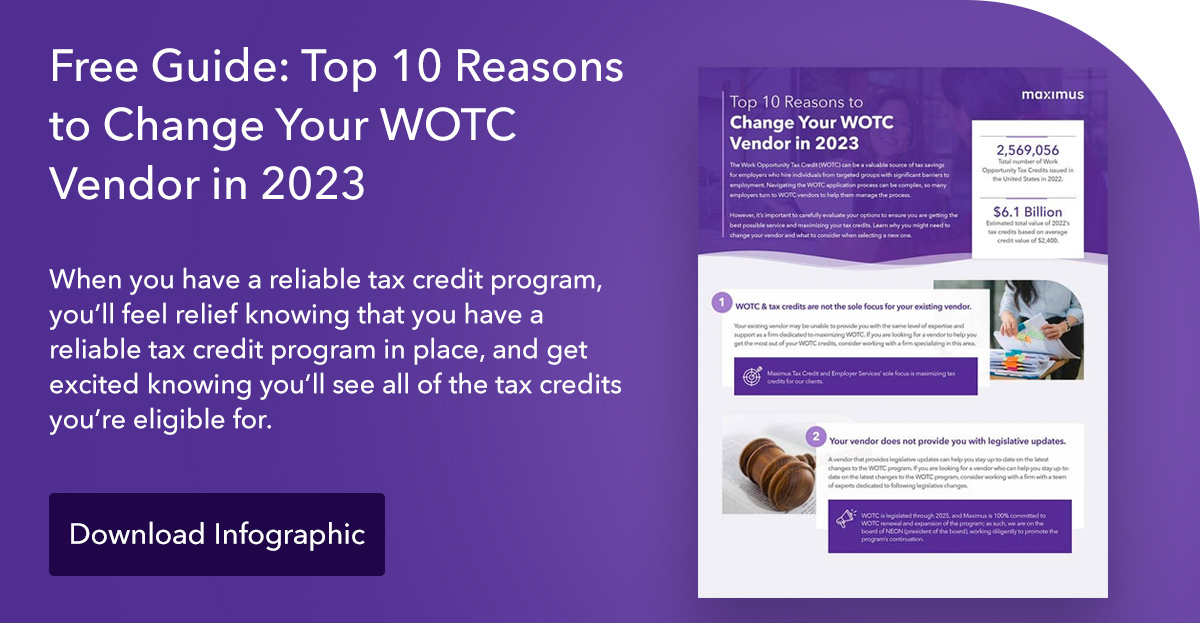Tips for Work Opportunity Tax Credits for your small business

Did you know that a federal program can help business owners save between $1,200 to $9,600 per qualified employee? It’s known as the Work Opportunity Tax Credit (WOTC). In this post, we’ll take a deeper look into the credits and how to qualify.
What Is the Work Opportunity Tax Credit?
The Work Opportunity Tax Credit is a federal hiring incentive. It is for businesses that hire employees from groups traditionally facing barriers to employment, including:
- Qualified veterans
- People with disabilities
- Long-term recipients of welfare
- Qualified ex-felons
- IV-A recipients
- Food stamp recipients
- Qualified Supplemental Security Income (SSI) recipients
- Long-term unemployment recipients
- Summer youth employees who live in federal empowerment zones
The Work Opportunity Tax Credit is authorized through December 31, 2025. You can use the WOTC calculator to determine your potential savings.
Tip #1: How to certify that your employees belong to target groups
Before they can claim the tax credit, employers must obtain certification that proves their new hire belongs to a targeted group. It is the employer’s responsibility to pre-screen and obtain certification from the designated state workforce agency. To satisfy the pre-screening requirement, the employer and job applicant must file a pre-screening notice (more on that later in this article).
After the WOTC has been approved, the employer can claim the employee as a tax credit for the general business expense category on their income tax return. The credit can be claimed against payroll taxes by tax-exempt employers.
Tip #2: Make sure you follow the appropriate application process
To get the WOTC credit for your small business, you need to complete the following steps:
- Fill out IRS Form 8850: Form 8850 (Pre-Screening Notice and Certification Request) pre-screens employees and lets you request to have your new employee certified as belonging to the WOTC target group. On page two of the form, the employer must provide four dates: the date they gave information to the candidate, the date they made the job offer, the hire date, and the day the employee started working.
- Fill out ETA Form 9061: Form 9061 is where you can list the employee’s characteristics, including their demographic information and other details that show they belong to the WOTC target group.
- Submit the forms: You have 28 days after the new hire starts to submit the forms. If you miss that window, your application will be denied.
- Receive a response: The state workforce agency will issue a determination for each application. Sometimes, they may ask for additional information or documentation. Once you receive your certification, you can claim the tax credit with the Internal Revenue Service (IRS).
- Claim your tax credit: File Form 5884 (Work Opportunity Credit) to claim your credit, unless your organization is tax exempt and you’re hiring a veteran. In that case, file Form 5884-C instead.
Tip #3: Know how much you can claim with a WOTC
You can claim between $1,200 to $9,600 per qualified employee, depending on their salary and the hours worked.
First-year employees must work 120 hours to qualify for the tax credit.
It is also possible for a company to claim the WOTC on 25% of wages if the employee works less than 400 hours but more than 120 hours in a year.
Tip #4: How to find job candidates in WOTC-Targeted groups
American Job Centers connect you with skilled job seekers in targeted groups. These nationwide centers help recruit talent, host job fairs, conduct skills assessments, and support workers transitioning to new jobs.
Some candidates are even pre-certified in a WOTC-targeted group, making the process a little easier.
Do you have to participate in the WOTC Program?
No. WOTC is a voluntary program, meaning employers are not required to participate or recruit eligible employees. As such, applicants aren’t required to fill out the WOTC eligibility questionnaire.
Are there benefits of the WOTC Program for employees?
We know employers benefit from tax credits from WOTC, but what about the employee?
The federal government designed the WOTC program to encourage employers to hire people from specific groups. These program incentives mean that people in the target groups are more likely to be hired, despite other employers and the rest of the world often leaving them in the margins.
Maximus can help with WOTC
Federal, state, and local tax credits can provide your organization with significant savings, yet taking advantage of them requires knowledge, time, and perseverance. Tax Credit and Employer Services (TCES) can help. Contact a Maximus expert today to learn more.
